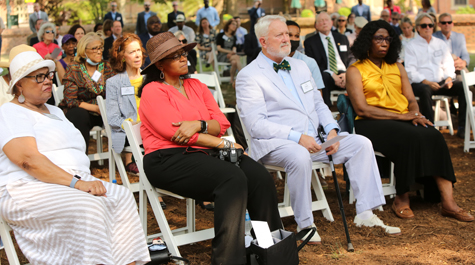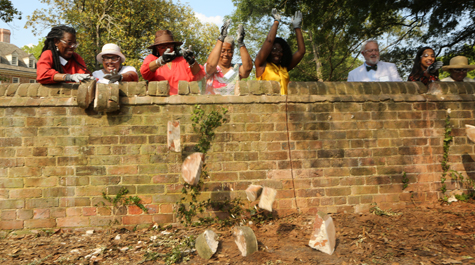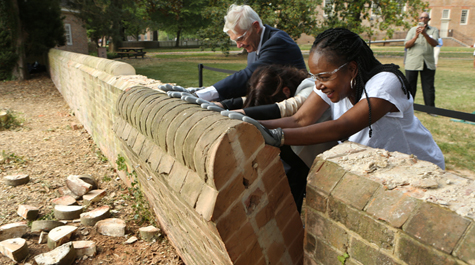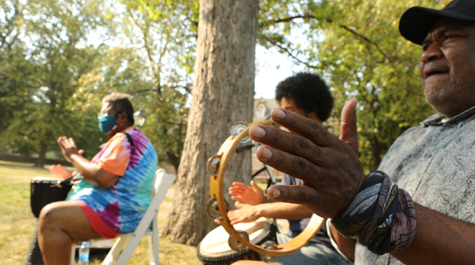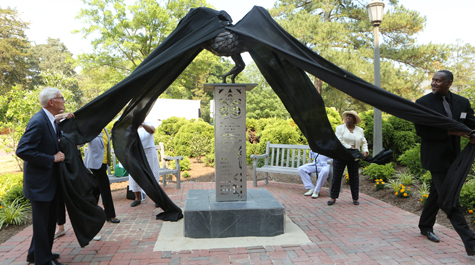‘We will remember’: Work begins on W&M’s memorial to the enslaved
In the shadow of a building where people enslaved by William & Mary once worked and lived, a memorial to those same people will soon be erected so that their stories and their role in the university’s history over the course of 172 years may be brought to light.
On May 26, the university hosted a ceremony to mark the beginning of construction on the memorial, to be completed in early 2022. Titled “Hearth: Memorial to the Enslaved,” the brick structure will resemble a fireplace and will feature the names of people who are known to have been enslaved by the university.
Situated between Ewell Hall and the Brafferton and across the street from the Office of Undergraduate Admission, it will serve as a gathering place for the community and as a reimagined entrance to the university’s Historic Campus.
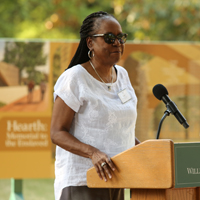 “We may never know all the names, but known and unknown, these people will live in our hearts and our minds as we break ground today for ‘Hearth: Memorial to the Enslaved,’” said Jody Allen Ph.D. ’07, assistant professor of history and Robert Francis Engs Director of the Lemon Project. “We know that, when finished, it will be a permanent structure on campus that will recognize and honor the enslaved who toiled lived, died, celebrated, mourned, loved, planned, executed and prayed on this campus.
“We may never know all the names, but known and unknown, these people will live in our hearts and our minds as we break ground today for ‘Hearth: Memorial to the Enslaved,’” said Jody Allen Ph.D. ’07, assistant professor of history and Robert Francis Engs Director of the Lemon Project. “We know that, when finished, it will be a permanent structure on campus that will recognize and honor the enslaved who toiled lived, died, celebrated, mourned, loved, planned, executed and prayed on this campus.
“While the past can't be changed, William & Mary recognizes its debt. Now that the institution knows better, it will continue to strive to do better, to make this a place of inclusion for all who study, work and visit — and it will remember.”
Along with remarks from multiple members of the university community, the event featured a reading of names of people known to have been enslaved by William & Mary (others are still unknown); a reading of the university’s land acknowledgement statement and a libation presented by Hermine Pinson, Frances L. and Edwin L. Cummings Professor, English and Africana Studies; and a performance of “Amazing Grace” by Andrea Harris, associate director of university events.
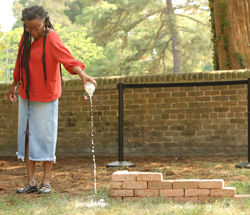 The ceremony also served to celebrate the completion of the Legacy Tribute Garden near Jefferson Hall and to unveil the new “Sankofa Seed” sculpture, which features an image of a bird that is looking backward while moving forward. Both are meant to honor the past, present and future Black members of the W&M community.
The ceremony also served to celebrate the completion of the Legacy Tribute Garden near Jefferson Hall and to unveil the new “Sankofa Seed” sculpture, which features an image of a bird that is looking backward while moving forward. Both are meant to honor the past, present and future Black members of the W&M community.
“This garden and this memorial will change how we understand our history of race and racism at William & Mary and in this country,” said W&M President Katherine A. Rowe. “It will stand testament to the power of durable change for the future by creating places for learning, for dialogue and greater understanding. My hope is that the Legacy Tribute Garden and the Memorial to the Enslaved will engender humility and invite authentic discourse.”
Rowe remarked on the timing of the memorial event, coming just one day after the first anniversary of the murder of George Floyd.
“This is a week when so many of us have been thinking about what it means to remember,” she said. “What is that work of commemoration, anniversary, memorialization? The mindfulness that we achieve through shared memory brings acknowledgement, affirmation, resistance, repair and ultimately solidarity even in the face of loss and grief. … The stories that we commemorate at William & Mary are centuries old. And as our partners at First Baptist Church and the Let Freedom Ring Foundation remind us, stories that are half told are untold, truly.
“So many stories are still here, all around us, waiting to be heard if we have the language, if we know the signs, if we can — through sustained research and discovery and sustained remembering — bring them back to voice.”
From idea to reality
The idea for the memorial came from a Student Assembly resolution that asked the university to research its history with slavery, share those findings publicly and establish a memorial to people once enslaved by W&M. That resolution led the Board of Visitors in 2009 to establish the Lemon Project, a long-term research endeavor that is exploring W&M’s history with slavery and discrimination and its ongoing relationship with the Black community.
{{youtube:large|3JwWBYWv05s, Highlights from the event}}
Under the leadership of President Emeritus Taylor Reveley LL.D. ’18, the Lemon Project Committee on Memorialization (LPCOM) was created in 2015, the same year that Reveley established the university’s Task Force on Race and Race Relations. In 2018, the university launched an international competition to solicit design concept ideas, and Reveley — in consulation with LPCOM — selected the jury, which included alumni, students, faculty and community members who were experts in such fields as history, architecture and museum studies. The winning concept was created by William Sendor ’11, who was in attendance at Wednesday’s ceremony.
“Today is the completion of the commitment that the Board of Visitors made and one small, but monumental step in this university's reckoning with its involvement in the horrific institution of slavery,” said Barbara Johnson J.D. ’84, secretary of the BOV. “Today represents the commitment of the Board of Visitors and the leadership of this university to make this campus inclusive for all.”
The project was made possible largely through private donations. Honorary alumnus J. Goodenow “Goody” Tyler III galvanized giving for the project during 2020’s One Tribe One Day — inspiring over 330 others to contribute to the memorial. Several alumni also made significant gifts to the project, including Elaine and Todd Stottlemyer ’85; Cliff Fleet ’91, M.A. ’93, J.D. ’95, M.B.A. ’95 and Fran Zemmel; and Rob ’74 and Jean Estes ’75.
The Board of Visitors also played a significant role in supporting the project, marking it as an institutional priority. Former Rector Jeffrey B. Trammell ’73 and all of the other living rectors of William & Mary made gifts toward the project along with current board members. When the university raised more than $1 million in private gifts, the Board matched it to complete the funding needed for the memorial.
“This hearth will serve as a reminder of the past and a hope for the future, providing a location to gather, discuss and flourish together regardless of your race, your religion or who you choose to love,” Tyler said.
Sankofa Seed
Prior to the event, a new sculpture was unveiled near Jefferson Hall, where the university’s first African Americans in residence — often referred to as the Legacy Three — lived at the university. Two of those alumnae — Lynn Briley ’71, D.Sc. ’18 and Janet Brown Strafer ’71, M.Ed. ’77, D.Sc. ’18 — attended the event. The third, Karen Ely ’71, D.Sc. ’18, was unable to attend, but her grandson and great-granddaughter were present.
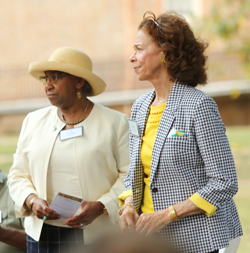 The sculpture was created by Steve Prince, director of engagement and distinguished artist in residence at the Muscarelle Museum of Art, in coordination with Michael Gaynes, a lecturer of art and art history. It features a Sankofa bird symbol, which originates in Ghana and represents looking at the past in order to move forward.
The sculpture was created by Steve Prince, director of engagement and distinguished artist in residence at the Muscarelle Museum of Art, in coordination with Michael Gaynes, a lecturer of art and art history. It features a Sankofa bird symbol, which originates in Ghana and represents looking at the past in order to move forward.
The bird in the sculpture is looking behind it “because it looks back at all the things which it came from and all the things that it went through,” said Prince.
“And that is what William & Mary must continue to do — look back at its past soberly in order for all of us to move forward together.”
The sculpture includes names and images representing Briley, Ely and Strafer as well as the names of other Black W&M students who made history at the university. It is made of stone, steel and bronze and will be illuminated at night.
Prince, Rowe, Reveley, Ely, Strafer and McLendon all helped to unveil the sculpture, which sits adjacent to the university’s new Legacy Tribute Garden, created to honor the Legacy Three.
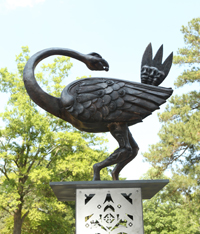 “The sculpture and garden stand as an acknowledgment of the contribution of past and current Black students, faculty and staff,” said Professor Emeritus Jacquelyn McLendon L.H.D. ’21, founding director of the university’s Black studies program and chair of the committee responsible for the 50th Commemoration of the First African American Students in Residence in 2017-2018.
“The sculpture and garden stand as an acknowledgment of the contribution of past and current Black students, faculty and staff,” said Professor Emeritus Jacquelyn McLendon L.H.D. ’21, founding director of the university’s Black studies program and chair of the committee responsible for the 50th Commemoration of the First African American Students in Residence in 2017-2018.
“It is an acknowledgement of firsts of diversity and inclusion of some of the many milestones and accomplishments the Black presence at William & Mary has helped to achieve,” she said. “Alumni, current students, faculty, staff and visitors of all races, religions, religious faiths, cultures and nationalities will find a welcoming place of fellowship and inspiration as well as the place to learn about the unique story of these three women and other pioneering African Americans — a story that is an integral part of the history of William & Mary as a whole. Indeed, it is a communal garden, offering a gathering place for the promotion of unity and belonging, a physical representation of the sentiment that who comes here, belongs here.”
Knocking down walls
While many W&M students take pride in the role W&M has played in American history, they also benefit from the forced labor of enslaved people, said Meghana Boojala ’22, W&M Student Assembly president. The Student Assembly is engaged in a plan to address systemic racial injustice at the university in order to make all students feel like they belong.
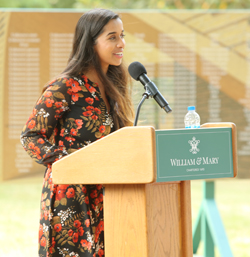 “Students can’t feel truly welcomed when our campus does not accurately represent history,” she said. “This memorial is a meaningful milestone in acknowledging 170 years of slavery on this campus. But we now have 158 remaining years of recent history to confront, and I look forward to the steps we take to tackle this complicated web of institutional inequality.”
“Students can’t feel truly welcomed when our campus does not accurately represent history,” she said. “This memorial is a meaningful milestone in acknowledging 170 years of slavery on this campus. But we now have 158 remaining years of recent history to confront, and I look forward to the steps we take to tackle this complicated web of institutional inequality.”
At the end of the event, Boojala joined other student representatives, community members, faculty, staff and alumni in pushing down the top of a brick wall that stands where the memorial will be constructed. Reveley, who supported the Lemon Project throughout his tenure as 27th president of W&M, joined Rowe and Allen to knock down a large panel of the wall.
“We clear a path in a way that honors our past and our present and that makes for great neighbors for the future,” said Rowe. “That is our commitment.”
William & Mary would not have existed without the people it enslaved, Johnson said.
“We may not know all your names; we may not know all your stories,” she said. “But this memorial will be a physical reminder of you. And yes, today, we will see you. We will hear you. We will thank you. We will honor you and include you and your greatness in the William & Mary story for all times coming.” Skip to main content
Skip to main content

